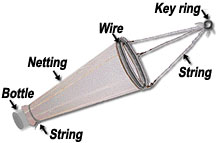
Plankton are floating or drifting organisms (e.g.,
plants and animals) that live in marine, estuarine and fresh water. Most
can only be seen under a microscope, yet they are remarkably abundant
in the world's oceans. It is estimated that phytoplankton -- the
plant forms of plankton -- photosynthesize more than all other
land and marine plants combined. This means they also produce most of
the oxygen breathed by humans and other animals. Phytoplankton are also
the basis of the marine food web. They are grazed upon by small
zooplankton who are in turn, eaten by small fish and other zooplankton.
Since most plankton are barely visible to the unaided eye, scientists
must use a special net to gather these small creatures. The plankton net
is a funnel-shaped, fine-meshed net that is towed through the water. The
net concentrates the plankton from hundreds of gallons of water that pass
through it.

- Plankton are floating or drifting organisms, generally microscopic, that live near the surface of the ocean or other bodies of water.
- Scientists must use special equipment to gather plankton
Microscope (optional), FOR EACH NET: Thin wire (20
inches in length), Duct tape, Electrical tape (optional), Nylon stocking
or a leg cut from panty hose, Heavy thread and needle, Small bottle, String,
Scissors, Key ring, Image of completed plankton net
The activity outlines the construction of a simple plankton
net. The students can work in groups, pairs, or alone. Have them bring
in the materials that they will need. They may wish to use knee-high stockings.
If so, they need to make the wire circle smaller. Make a net to use as
a display to help guide the students' construction. You may choose to
tow for plankton in ponds, lakes, streams, bays, oceans, even aquariums.
Although you can buy plankton nets from science supply stores, it is cheaper
and more fun to have the students make them. Ideally, you could organize
a field trip once your nets are finished to gather plankton. There are
several methods that you can use to tow for plankton. The standard method
involves pulling the net behind a slowly moving boat. Lower the net vertically
into the water until the bottle (at the end of the net) is filled with
water. Then pull until the net is extended and begin to tow. After a few
minutes, bring the net in and let it hang for a few minutes. Wash all
the plankton into the bottle by running fresh water from the outside of
the net. You will capture more plankton if the boat moves slowly. If a
boat is not available, you can tow the net as you walk along a dock. You
can also throw the net from a bridge or a pier into a fast-moving current.
Plankton are organisms that drift on the ocean's currents
and in lakes and rivers. They are abundant is the surface waters where
sunlight and nutrients are readily available. Phytoplankton are microscopic
plants that convert sunlight and nutrients to starch and other organic
matter. In this activity, you will make a simple plankton net from wire
and a nylon stocking. The net is a funnel-shaped, fine-mesh net that is
towed through the water.
- Bend the wire into a circle and use the electrical tape or duct tape to fasten the loose ends together.
- Roll the mouth of the stocking several times around the wire ring. Sew the stocking to the wire using the heavy thread and needle. Alternatively, use duct tape to secure the stocking all the way around the wire.
- Cut off the foot of the stocking, and then place the end of the stocking around the outside of the mouth of a small bottle. Use a piece of heavy string to tie the stocking securely to the top of the bottle. Use duct tape to reinforce the connection between the bottle and string.
- Cut three pieces of string, each about 20 inches (50 cm) long, to make the bridle to tow your net. Tie them at equal intervals around your ring. Tie the three loose ends of string to a key ring. This is the bridal ring. Your plankton net is complete!
- To tow for plankton, tie a length of string to your bridal ring and pull your net through the water. The plankton will collect in the bottle. Remove the bottle by untying the string. View your plankton through a microscope.
- Why did we use nylon stockings as part of the net? What would happen if you made a plankton net out of burlap? Why is it important to use a fine mesh when constructing a plankton net?
- During your experiment, you may want to collect another bottle (with known volume) of water without a plankton net. Filter this non-concentrated water sample and look at the plankton through a microscope. Compare the amount of plankton to the concentrated sample collected with the plankton net. Based on the volume of the non-concentrated sample, can students guess the volume of water that filtered through the plankton net?
- Because plankton are the basis of the ocean food chain it is important to monitor natural as well as human-caused changes in plankton population. Students can adopt an area (lake, stream, or beach area) to monitor plankton concentrations over time. Try to discover which types of seasonal changes affect plankton population. What kind of non-natural processes might help or hurt plankton growth?
- You can use plankton collected with these plankton nets in conjunction with the Plankton Identification activity.
Adapted from Kolb, James A. Project
Director. Marine Science Center. Marine Science Project: FOR SEA. Marine
Biology and Oceanography, Grades Seven and Eight. Poulsbo, WA. Page 341
-344. AND "Visit
to an Ocean Planet" CD-ROM, Copyright 1998, California Institute
of Technology and its licenses.






